|
The Spirit Lake, Iowa, area has an old and
interesting history. To help keep these
memories alive, the Ladies of the Lake
Chapter, NSDAR, has marked these historical
areas.
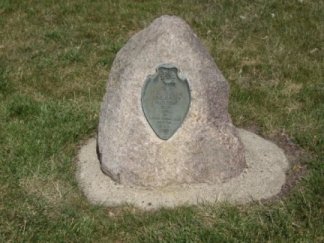 Site of
the Granger Cabin Site of
the Granger Cabin
Location: 1200 U.S.
Highway 71S, Okoboji, Iowa, on the
Okoboji Town Hall lawn
History: Four young
bachelors from Red Wing, Minnesota,
were massacred by Indians at this
cabin in 1857. They were Carl
Granger, Dr. I. H. Harriott, Bertell
A. Snyder, and Joseph Harshman. The
site is marked in commemoration of
the Bicentennial of the United
States by a bronze plaque on a
native boulder. The marker was
placed by the Ladies of the Lake
Chapter, NSDAR, in 1928.
|
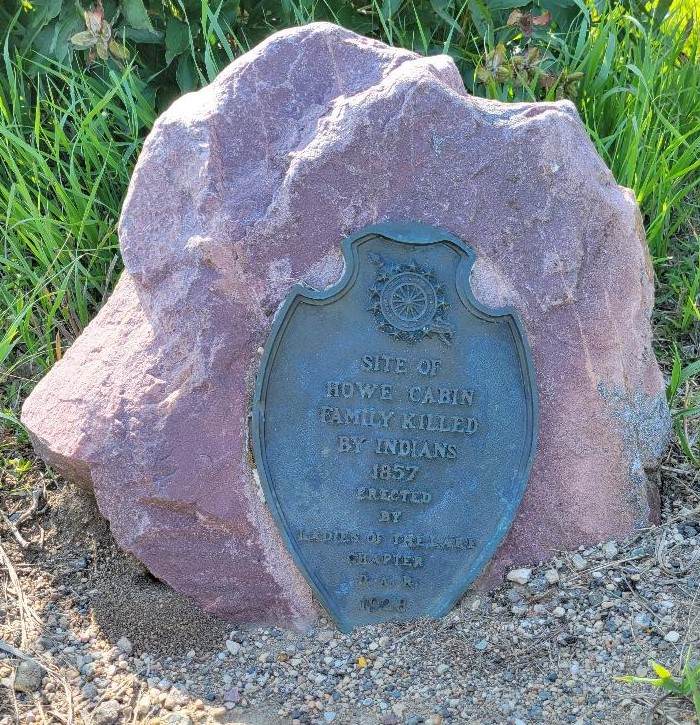
Site of the Howe Cabin
Location: 1769 - 260th
Avenue (Highway M56), Spirit Lake,
Iowa
History: The family of
Joel Howe and his wife and six
children were murdered by the
marauders. The cabin was located on
the east shore of East Okoboji Lake,
about four miles distance from the
Gardner site. The marker is placed
on the roadside, just north of the
Camp Foster YMCA turn-off, directly
in front of a farm site.
|
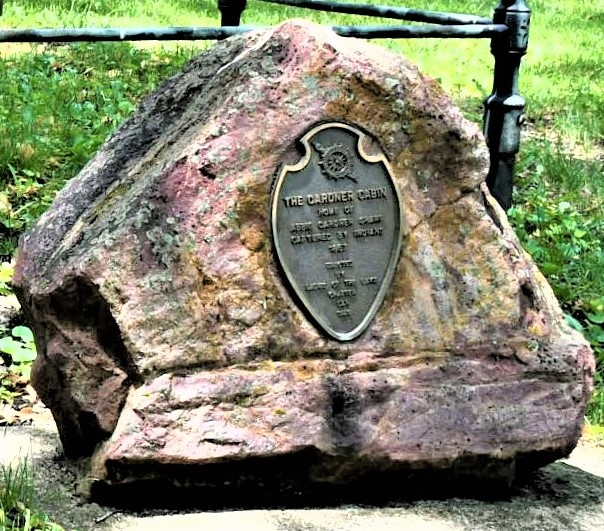 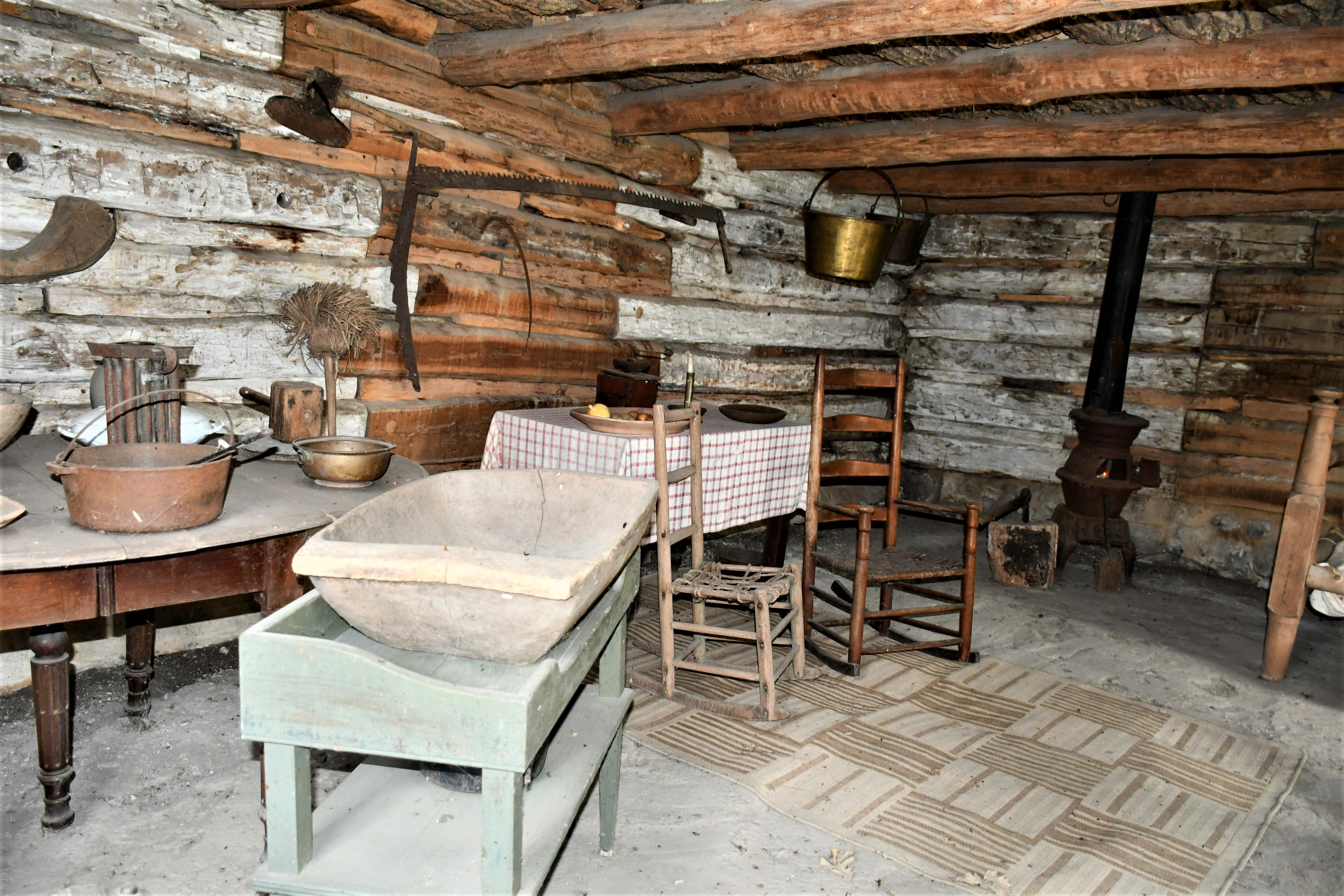 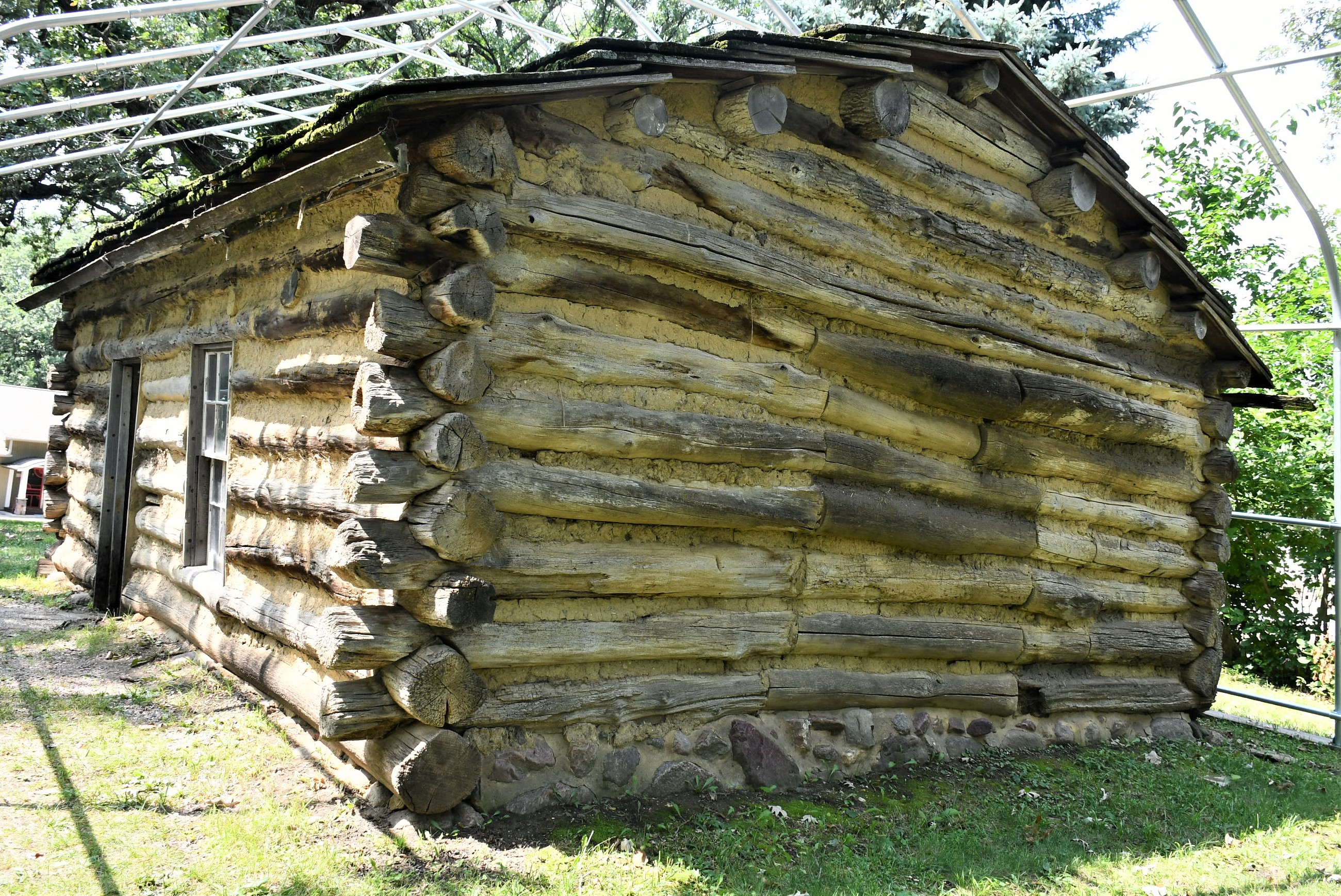 Original Gardner Cabin
Original Gardner Cabin
Location: 74 Monument Drive, Arnolds
Park, Iowa. U.S. Highway 71 is
well-marked for finding the Gardner
Cabin.
History: The Rowland
Gardners, nine members in all, came
to the Spirit Lake region by covered
wagon in 1856. Originally from
Seneca, New York, they came as far
as Ohio, stayed a few years, then
moved on to Iowa. The entire family,
except Abbie, 13, and her sister
Eliza, died outside the cabin at
Okoboji during the March 8, 1857,
massacre by renegade Indians, led by
Inkpaduta of the Sioux tribe. In
1891, Abbie returned to the area,
purchased the cabin, and preserved
it until she died in 1921. The
marker for the cabin was placed by
the Ladies of the Lake Chapter,
NSDAR, in 1928.
|
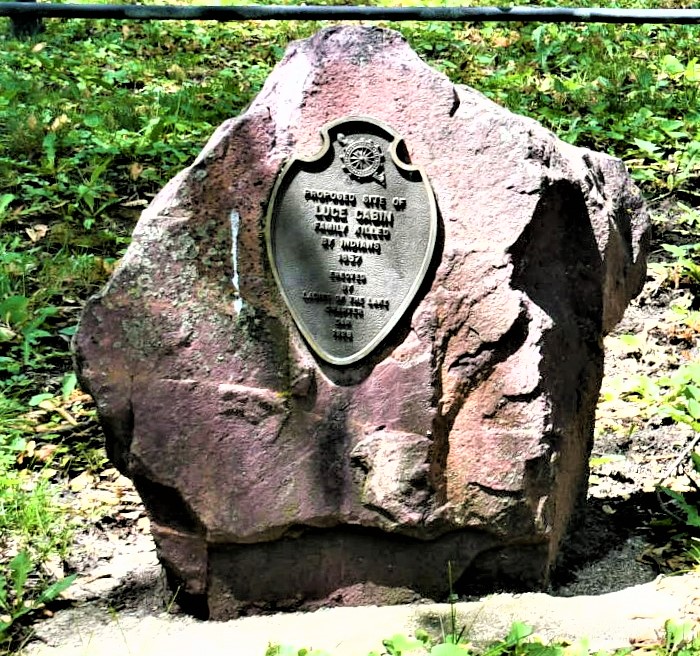 Site
of Luce Cabin Site
of Luce Cabin
Location: 74 Monument
Drive, Arnolds Park, Iowa. The cabin
is located a quarter mile east of
the Gardner cabin on Pillsbury Point
of West Lake Okoboji.
History: Luce was a
son-in-law of the Gardners, married
to their daughter, Mary. He and
Mary, along with their two children
were living with the Gardners as
Luce was starting to build their
cabin, just east of the Gardner
cabin. Mary and the two children
were killed with the rest of the
Gardner family. Luce was killed on
his way to warn other settlers
living on East Lake Okoboji. The
marker was placed by the Ladies of
the Lake Chapter, NSDAR, in 1928.
|
Site of Mattock
Cabin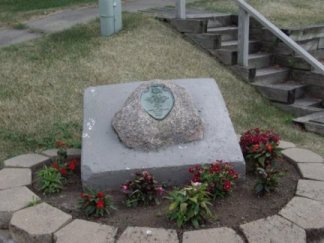
Location: 351 N
Highway 71, Arnolds Park, Iowa. This
site is on Highway 71 at the extreme
north edge of the city of Arnolds
Park, two blocks south of the
Okoboji Bridge at the entrance of
the City of Okoboji.
History: The cabin,
where James Mattock, his wife, five
children, and Mr. Robert Bruce
Mathieson lived, was destroyed and
the people within burned by
Inkpadutah of the Sioux tribe. After
the attack at the Gardner cabin, and
taking Abbie as prisoner, the
Indians retraced their path past the
Mattock cabin, which was still
burning, with the screaming victims
inside.
|
Site
of Thatcher and Noble Markers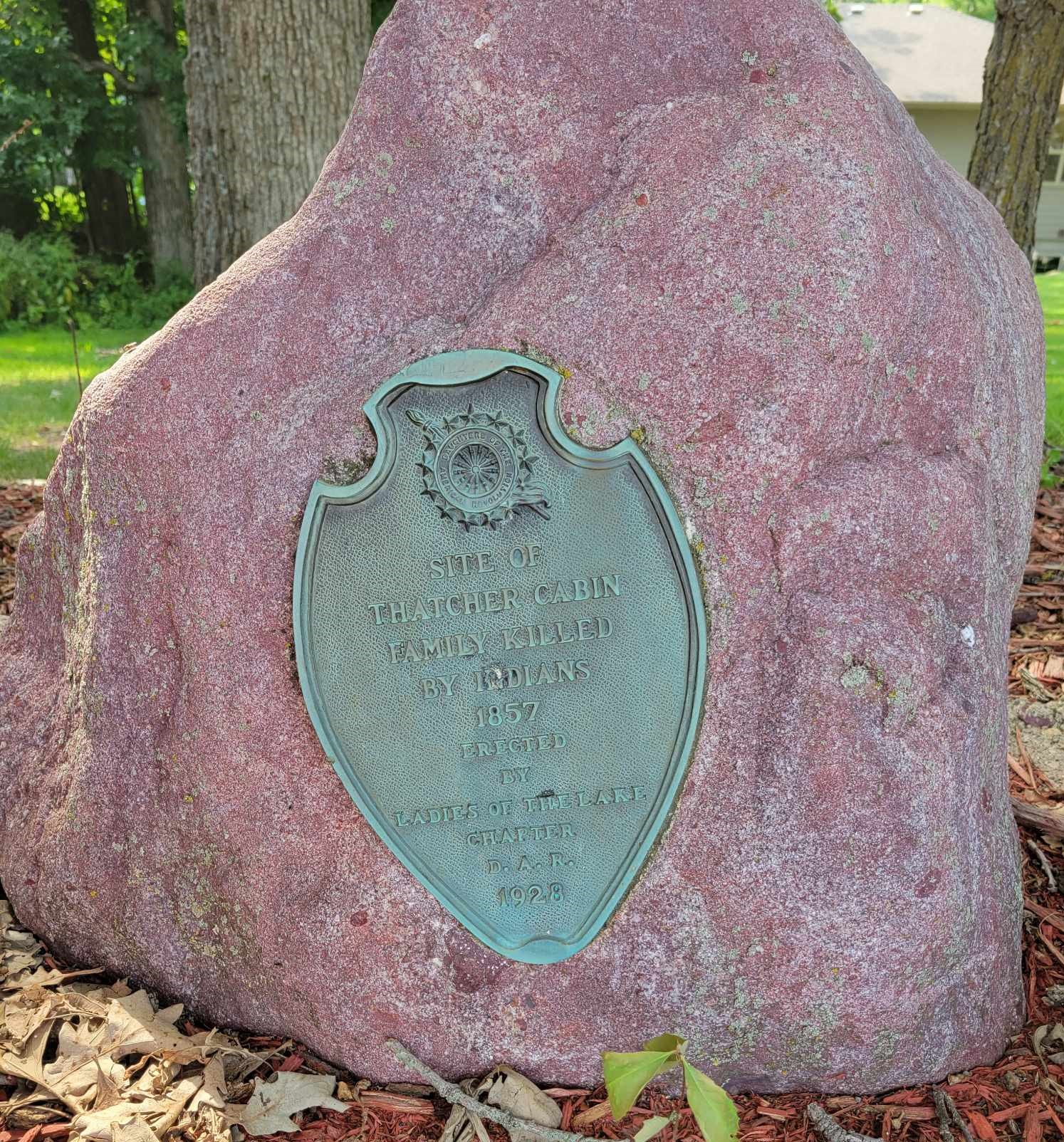 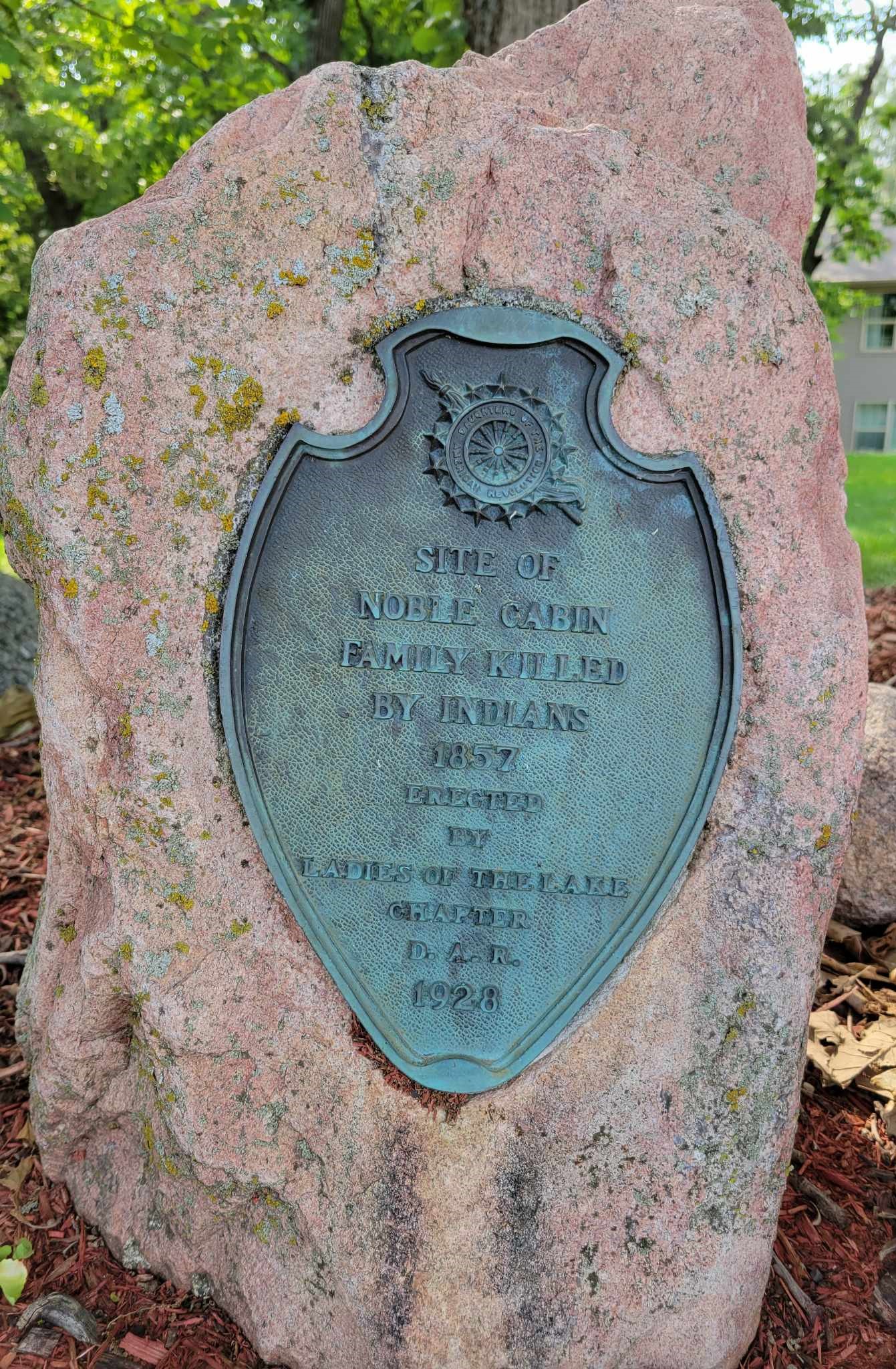
Location: 1687 260th
Avenue, Spirit Lake, Iowa. The
Thatcher and Noble markers are
located near the Joel Howe Cabin
marker. They are a mile north of the
Howe site on the east side of East
Lake Okoboji.
History: The Thatcher
family was sharing their cabin with
the Noble family while they were in
the process of building their cabin
home. Mrs. Noble was a daughter of
the Howes and a cousin of Mrs.
Thatcher. Mr. Noble, the Nobles'
child, Mr. Ryan (a brother-in-law),
and the Thatcher baby were murdered.
Mrs. Noble and Mrs. Thatcher were
taken captive and Mrs. Noble was
killed when she refused the advances
of an Indian. Mrs. Thatcher was
drowned in an icy stream near
Flandreau, Minnesota when she fell
from a log while crossing, and the
Indians held her under. Mr. Thatcher
had been delayed on his return from
Waterloo, Iowa, for provisions, and
so escaped.
|
 Site of
Marble Cabin Marker Site of
Marble Cabin Marker
Location: 3200 Highway
276, Spirit Lake, Iowa. The Marble
Cabin marker is located mid-way on
the west shore of Spirit Lake.
History: On March 10,
1857, Inkpaduta, his Sioux warriors,
and their captives crossed West
Okoboji Lake on the ice and went up
the west side of Big Spirit Lake to
the William Marble home. Their
arrival was unexpected. Mr. Marble
was shot and his wife was taken
hostage. On May 6, 1857, two Yellow
Medicine Reservation Indians traded
blankets, ammunition, and guns for
her. The Indians were later paid a
thousand dollars.
|
Site of Stockade --
Protection from Indians
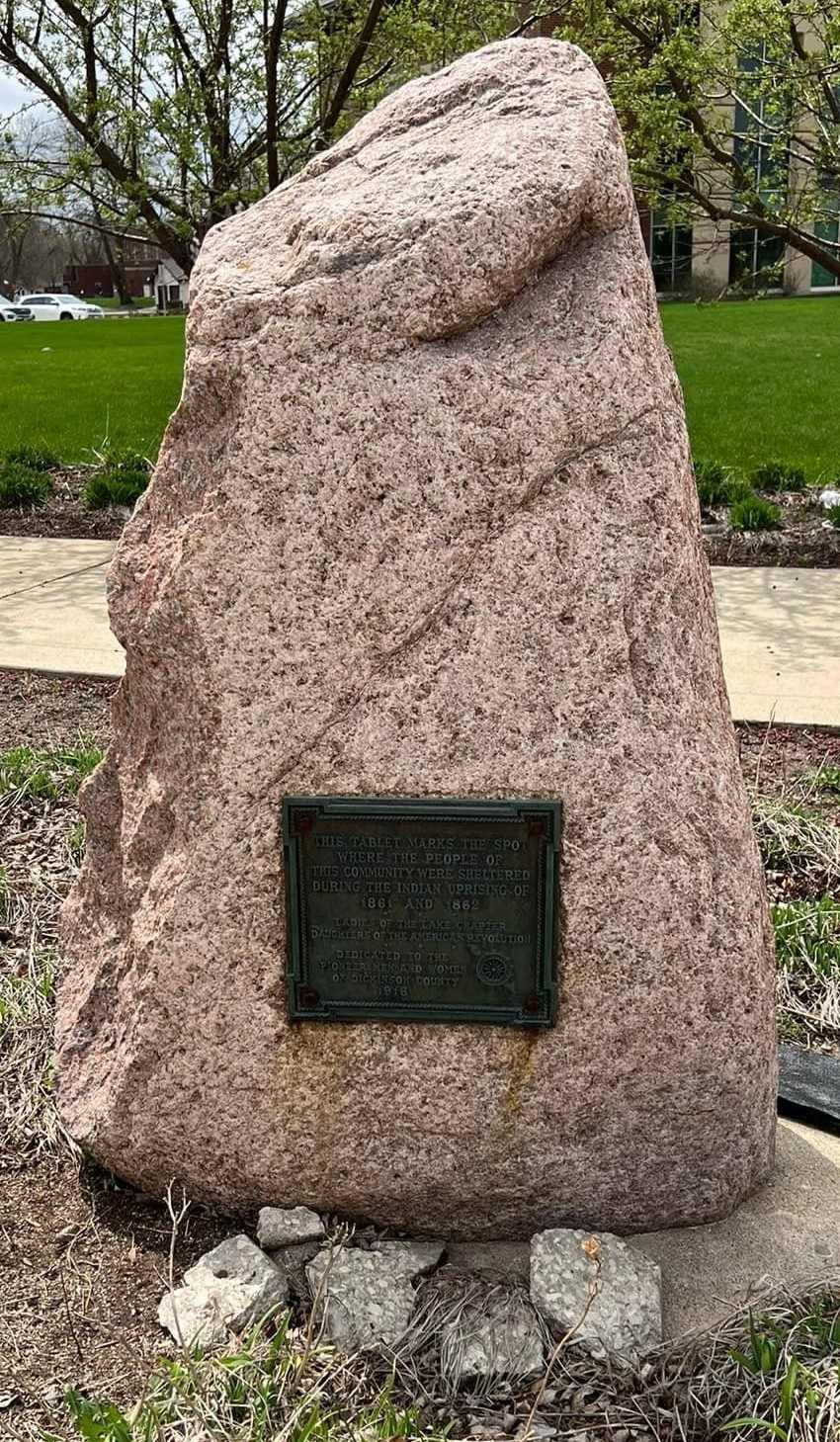 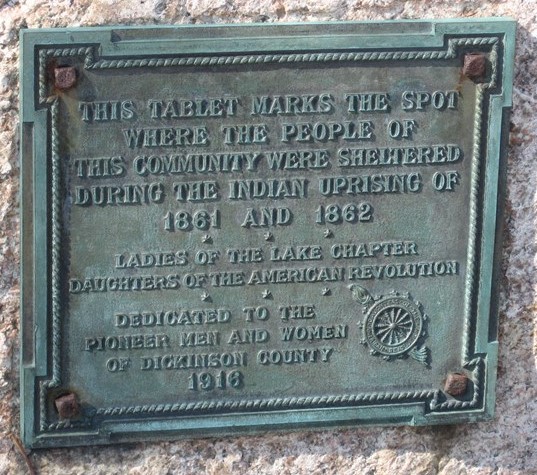 Location:
1802 Hill Avenue, Spirit Lake, Iowa. Location:
1802 Hill Avenue, Spirit Lake, Iowa.
History: On August 23,
1916, a granite boulder was placed
on the front lawn of the Dickinson
County Court House at 1802 Hill
Avenue, Spirit Lake, Iowa. It was
re-dedicated in 2009 by the Ladies
of the Lake Chapter, NSDAR, when a
new courthouse was built and the
marker moved to the corner with
flowers around it. The bronze tablet
dedicates this site to the "Pioneers
of 1862." This was the location of
the old stockade where upwards of
forty families sought shelter from
the Indians. Many who were taken to
this stockade as children were
present for the dedication in 1916.
Living elderly members were also in
attendance. We revere these hardy
pioneers and the contributions each
would have made. Their martyrdom,
however, has given each of them, and
this area, a prominent place in
history. Several of the Ladies of
the Lake Chapter, NSDAR, members are
descendants.
|
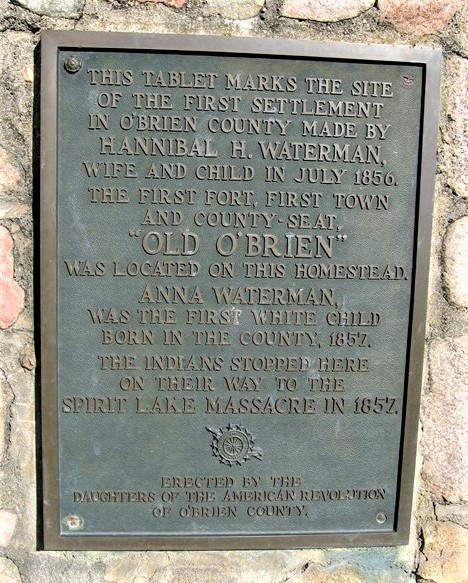 First
Settlement in O'Brien County First
Settlement in O'Brien County
Location: Five miles
east of Sutherland, Iowa, in O'Brien
County. This marker is located about
a half mile north of Highway 10,
across from the nature center.
History: The Waterman
home and family were attacked by the
Sioux Indians led by Inkpaduta on
their way to the Spirit Lake
Massacre. Anna Waterman was the
first pioneer child born in O'Brien
County. Members of the Ladies of the
Lake Chapter, NSDAR, are descendants
of the Waterman family and share
this history with the chapter. The
site was marked with a bronze plaque
by five DAR chapters. The text
reads: “This tablet marks the
site of the first settlement in
O’Brien County made by Hannibal H.
Waterman, wife and child in July
1856. The first fort, first town
and county-seat, “Old O’Brien” was
located on this homestead. Anna
Waterman, was the first white
child born in the county, 1857.
The Indians stopped here on their
way to the Spirit Lake Massacre in
1857.” Erected by the
Daughters of the American Revolution
of O’Brien County. |
The Old Fort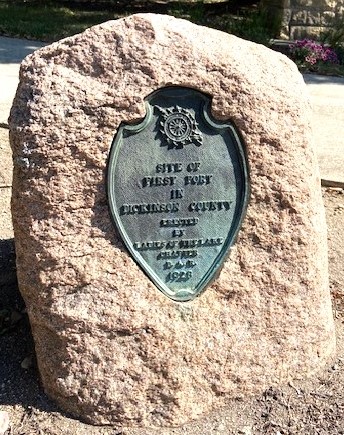
Location: 1005
Hill Avenue, Spirit Lake, Iowa
History: The “Old
Fort” was the site of the old Army
encampment. A company was enlisted
in pursuance of a special order of
the Secretary of War and operated as
an independent organization from the
fall of 1861 to the spring of 1863.
They later joined the 7th Iowa
Calvary as Company I, under the
leadership of A. Kingman. The
building, constructed of logs, was
25 x 30 feet with a shake roof and
puncheon floor and door. The marker
reads “Site of the first fort in
Dickinson County. Erected by the
Ladies of the Lake Chapter DAR
1928.” |
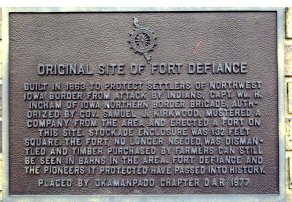 Original
Site of Fort Defiance Original
Site of Fort Defiance
Location: At
South 6th Street and 1st Avenue
South on the Fort Defiance
Professional Building, Estherville,
Iowa
History: The fort was
built in 1863 to protect settlers of
the northwest Iowa border from
attack by Indians, Captain William
H. Ingham of the Iowa Northern
Border Brigade, authorized by
Governor Samuel J. Kirkwood,
mustered a Company from the area and
erected a fort on the site. The
stockade enclosure was 132 feet
square. The fort, no longer needed,
was dismantled and timber purchased
by farmers can still be seen in
barns in the area. Fort Defiance and
the pioneers it protected have
passed into history. The marker was
placed by the Okomanpado Chapter,
NSDAR, in 1977. The Okamanpado
Chapter, NSDAR, of Estherville,
Iowa, merged with the Ladies of the
Lake Chapter, NSDAR, in the 1990s.
|
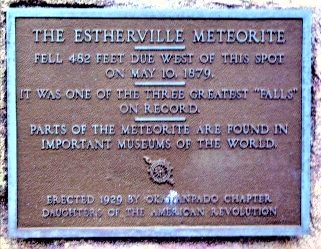
The Estherville Meteorite
Location: Highway 4
North, Estherville, Iowa.
History: The meteorite
fell 482 feet due west of "this
spot," a few miles north of
Estherville, on May 10, 1879. It was
one of the three greatest "falls" on
record. Parts of the meteorite can
now be found in museums around the
world. The original spot was marked
in 1929 by the Okamanpado Chapter,
NSDAR, of Estherville, Iowa.
|
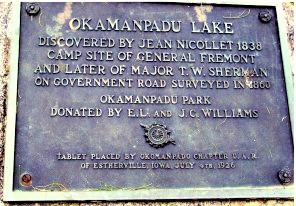
Okamanpadu Lake
History:
Discovered by Jean Nicollet in 1838,
and a campsite of General Fremont
and later of Major T. W. Sherman on
Government Road. It was surveyed in
1860. Okamanpadu Park was donated by
E. L. and J.C. Williams. The marker
was placed by the Okamanpado
Chapter, NSDAR, of Estherville,
Iowa, on July 4, 1926.
|
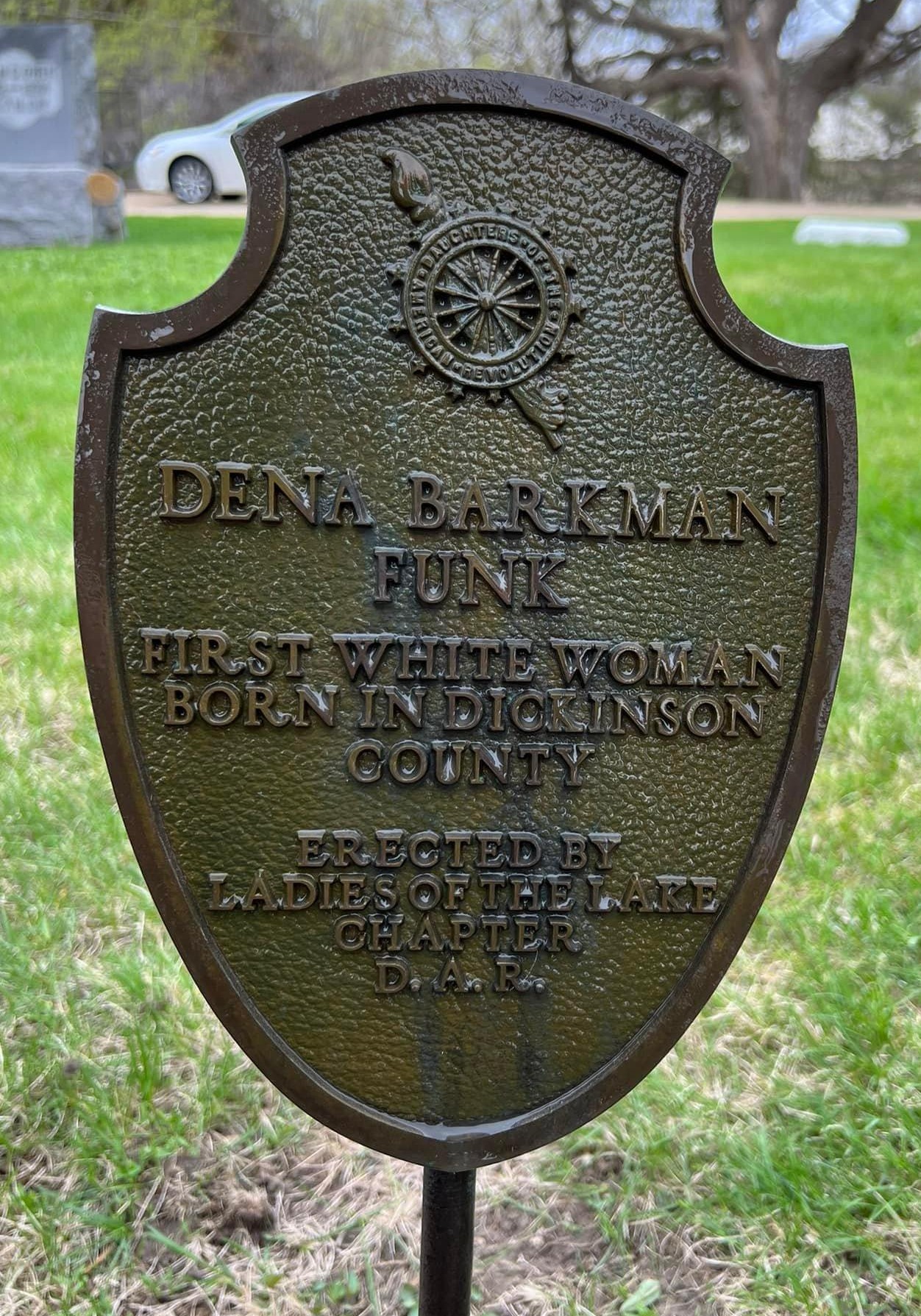 First
Pioneer Child Born in Dickinson
County First
Pioneer Child Born in Dickinson
County
Location: Lakeview
Cemetery, Spirit Lake, Iowa
History: Mrs. Dena
Borkman Funk was the first pioneer
child born in Dickinson County. Her
grave at Lakeview Cemetery was
marked by the Ladies of the Lake
Chapter, NSDAR, with a bronze plaque
on September 11, 1937.
|
Train Depot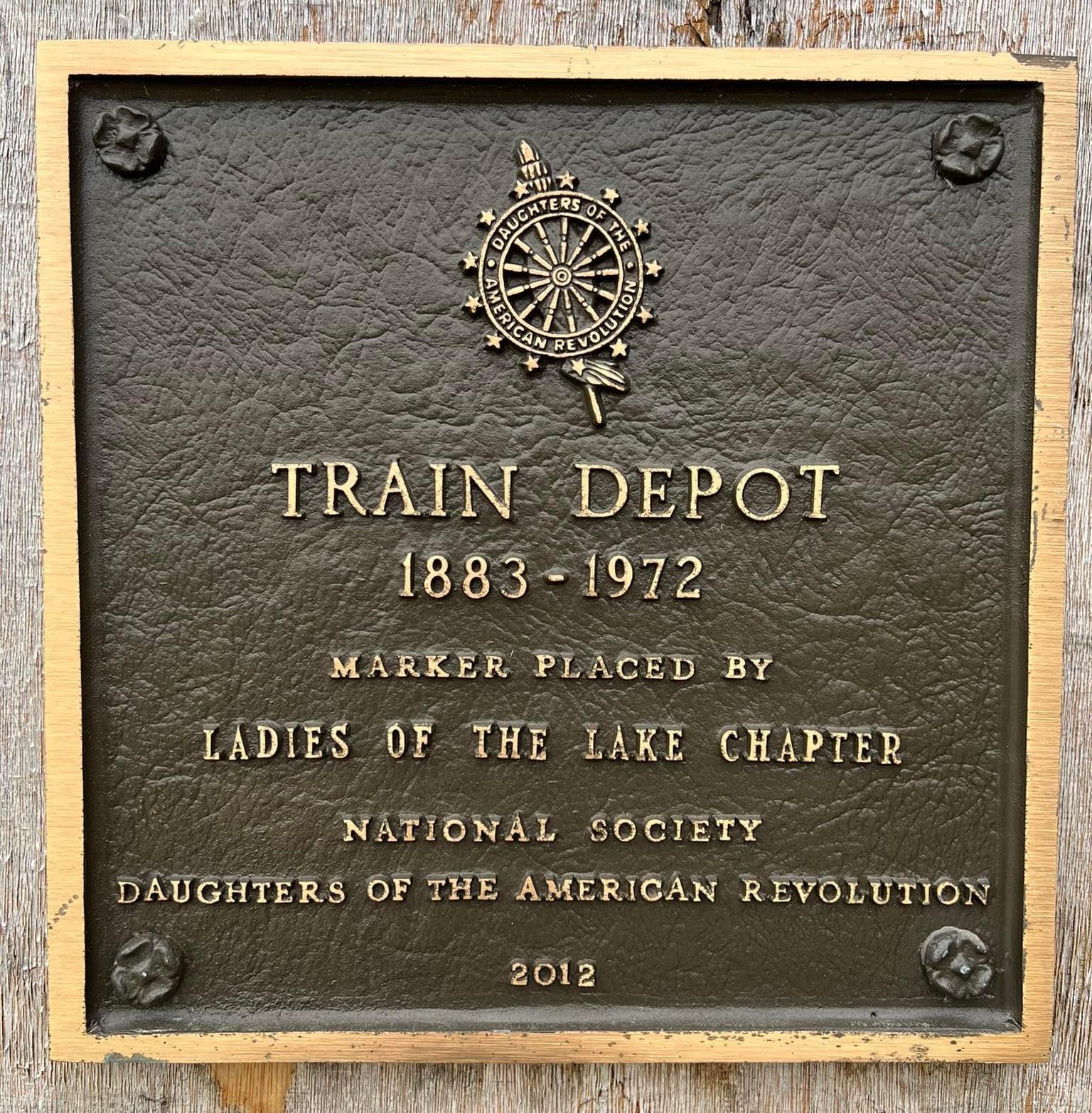
Location: 1708 Keokuk
Avenue, at the corner of Keokuk Ave
and Highway 71 on the north side of
the street, right by the old
railroad tracks.
History: The Dickinson
County Museum is in a 140-year-old
depot. It is essentially unchanged
since its 1883 construction with
indoor plumbing and electricity
added at some point. It was built by
the Chicago, Milwaukee, and St. Paul
Railroad, the Milwaukee Road, as the
northern terminus of the line from
Spencer. It is remarkable that the
depot still stands at its original
location on the railroad right of
way. It is the only such depot left
in the county. In 1972 the depot
closed its doors for the last time.
In 1973, the Dickinson County Museum
moved to the former Chicago
Milwaukee depot in Spirit Lake, and
in 1975 the Historical Society
purchased the depot. The museum
provides unique educational
experiences based on authentic
objects, stories, and lives from
Dickinson County. The purpose is to
inspire people to learn from those
artifacts through public programs,
publications, educational
activities, and special events. The
marker is placed to the right of the
main entrance to the museum on the
side of the building. In 2012 the
Ladies of the Lake Chapter, NSDAR,
placed this marker honoring the
train depot as an active station
1883-1976. |
|

